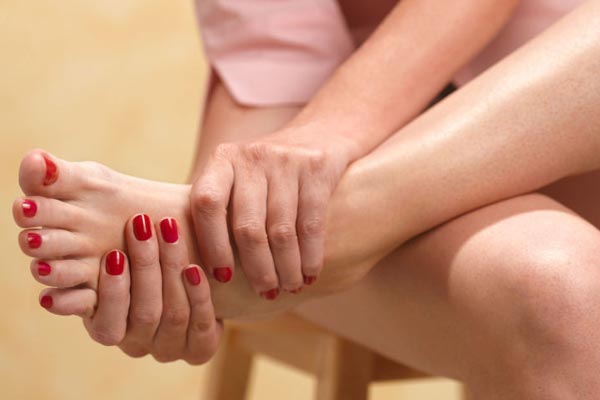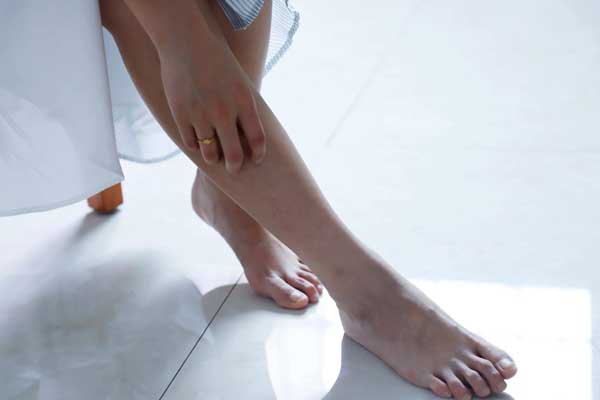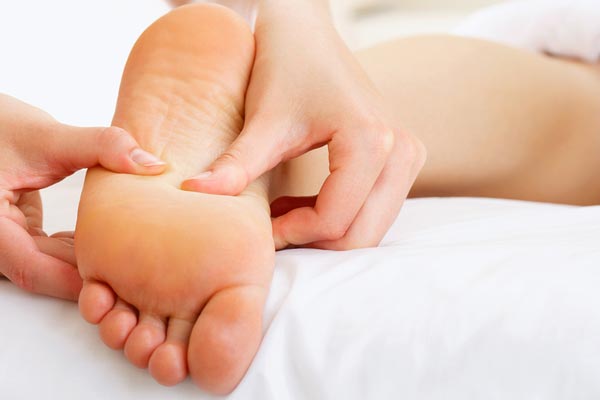A Look at Fibromyalgia Foot Pain and Treatment Options: Tired of Tired Feet?
Taking the Pain Out of Fibromyalgia Foot Pain
Have you noticed that your feet feel slightly more tender than usual? It could be fibromyalgia-related foot pain.
Fibromyalgia is a condition that can cause widespread pain throughout the body, and one of the places where it’s most commonly felt is in the feet. Let’s look at fibromyalgia and how to deal with its foot pain.
What Causes Fibromyalgia Foot Pain?
As with other areas of the body affected by fibromyalgia, foot pain can be caused by several factors, including inflammation and nerve damage.
Inflammation occurs when white blood cells accumulate around trigger points or tender spots in the muscles and soft tissues of the feet.
This can lead to swelling, redness, and increased sensitivity to touch. Nerve damage can also create numbness or tingling sensations in the feet and sharp shooting pains in certain areas.
Common Symptoms of Fibromyalgia Foot Pain
Imagine walking around with a weight on your feet all day. Sounds pretty tiring and painful. Well, for many people with fibromyalgia, that’s exactly how they feel – like they always weigh their feet.
Fibromyalgia foot pain can be an excruciatingly uncomfortable experience, making it difficult to do even the most basic tasks. Let’s check the common symptoms of fibromyalgia foot pain.
Painful Sensations in the Feet and Legs
One of the most common symptoms of fibromyalgia foot pain is intense pain or tightness in the feet and legs.
In extreme cases, these sensations can be so severe that walking or moving around becomes typically difficult. People with this condition may also experience burning sensations in their feet or feel like pins are stuck in them.
Numbness and Tingling
In addition to painful sensations, people with fibromyalgia foot pain may also experience numbness or tingling in their feet or legs. This can make it difficult to stand for long periods or put pressure on certain parts of their body when walking.
It’s crucial to know that if you are experiencing any numbness or tingling sensation in your legs, you should seek medical attention as soon as possible, as this could indicate another underlying medical condition.
Swelling
Another symptom commonly associated with fibromyalgia foot pain is swelling. People with this condition often experience swelling around the ankles and toes, which can be uncomfortable and make walking difficult due to increased pressure on the feet and lower legs.
Suppose you are experiencing swelling in your feet. In that case, it is essential to consult a doctor as soon as possible, as this could indicate an underlying medical issue such as arthritis or diabetes.

The Fibromyalgia Foot Pain Fixer: Stretching Exercises to Get You Moving Again
Living with fibromyalgia can be extremely painful and tiring. For many, foot pain is one of this condition’s most common and persistent symptoms.
Fortunately, some stretching exercises can help you relieve the pain and get back on your feet. Let’s look at some of the best stretches for fibromyalgia foot pain!
Toe Curls
Start by sitting in a comfortable chair with your feet flat on the floor. Place both hands under your feet and curl them up towards your shins as far as possible without causing pain or discomfort.
Hold this position for 10 seconds before returning your toes to the ground. Repeat this exercise for 2-3 sets of 10 repetitions each day.
Seated Calf Raises
Sit in a chair with your feet flat on the ground. Lift both heels off the floor simultaneously and hold them up for 5 seconds before slowly lowering them back to the floor. Again, repeat this exercise for 2-3 sets of 10 repetitions daily.
Ankle Circles
Sit in a chair with your feet flat on the ground. Create circles with both ankles clockwise and then counterclockwise, ensuring you stay within what’s comfortable. Do 10 circles in each direction per set, and perform 2-3 sets each day.
Stretching & Strengthening Exercises
Regarding reducing foot pain, stretching and strengthening exercises can be incredibly helpful. Daily stretching helps keep your muscles loose, preventing cramping and spasms.
Focus on stretches that target the calf muscles, which tend to be significantly affected by fibromyalgia-related pain.
Strengthening exercises help strengthen the muscles and tendons to provide better support for your feet when walking or standing for prolonged periods. Low-impact activities such as yoga and pilates are great options for strengthening exercises.
Taking Care of Your Feet When Living With Fibromyalgia
Fibromyalgia is a condition that can cause chronic pain and fatigue throughout the body, including in the feet.
There are ways to reduce foot pain and make your life more comfortable. Let’s look at some lifestyle changes you can make to relieve foot pain from fibromyalgia.
Wear Supportive Shoes
Your shoes significantly impact your comfort level when dealing with fibromyalgia-related foot pain. Choose shoes that fit correctly and provide good arch support—it may take some trial and error until you find the best for you.
It’s also a good idea to avoid wearing high heels or other uncomfortable shoes for long periods if possible, as these can lead to even more discomfort daily.
Rest & Relaxation
Finally, it’s important to remember that rest is essential when dealing with fibromyalgia-related foot pain. When our bodies are tired and overworked, they become vulnerable to injury and inflammation—so get plenty of rest when needed!
Find ways to relax after a long day, such as soaking in an Epsom salt bath or listening to soothing music—whatever helps you unwind!
Essential Oils for Fibromyalgia Foot Pain Relief
Fibromyalgia can be a painful and debilitating condition. One of the most common symptoms is foot pain, which can be challenging to manage. Fortunately, essential oils are a natural and effective way to relieve fibromyalgia foot pain. Read on to find out more!
How Can Essential Oils Help with Fibromyalgia Foot Pain?
Essential oils are known for their anti-inflammatory properties, which makes them an ideal treatment for fibromyalgia foot pain.
Essential oils like lavender and peppermint may help reduce foot inflammation and relieve pain and stiffness. Some essential oils, such as eucalyptus oil, may help reduce stress levels, which can often worsen fibromyalgia symptoms.
Which Essential Oils Should I Use?
The essential oil you use will depend on your individual needs and preferences. Some popular options include lavender oil, eucalyptus oil, peppermint oil, rosemary oil, ginger oil, lemongrass oil, and chamomile oil.
You can also blend different essential oils to create a custom scent tailored just for you! Do some research before using any essential oils, as some may not be suitable or safe if you have certain health conditions or allergies.
Over-the-Counter Medications That Can Help with Fibromyalgia Foot Pain
If you have fibromyalgia, you know the worst symptom is often foot pain. It can be hard to make it through your day when your feet are aching and throbbing.
Fortunately, there are several over-the-counter medications available that can help alleviate fibromyalgia foot pain. Let’s check some of them.
Ibuprofen
Ibuprofen is a commonly used over-the-counter medication for fibromyalgia. It’s an anti-inflammatory agent that helps reduce inflammation and swelling in the feet and relieve pain and tenderness.
Ibuprofen also helps lessen stiffness and soreness associated with fibromyalgia foot pain. However, it should not be taken by those with kidney or liver problems or those who are pregnant or nursing.
Acetaminophen
Acetaminophen is another common over-the-counter medication for fibromyalgia foot pain. It reduces fever and decreases muscle aches, which makes it helpful in treating conditions such as plantar fasciitis and shin splints, two common causes of fibromyalgia foot pain. However, acetaminophen should not be taken if you have liver disease or if you consume more than three alcoholic drinks per day.
Topical Creams
Topical creams such as Tiger Balm or Icy Hot can be applied directly to the skin to relieve foot discomfort caused by fibromyalgia temporarily.
These creams contain menthol, which helps numb the area and relieve the burning sensation associated with fibromyalgia foot pain. They also have capsaicin extract, which helps reduce inflammation and swelling in the affected area for faster recovery.
Best Home Remedies for Fibromyalgia Foot Pain
If you have fibromyalgia, chances are you’ve experienced foot pain at some point. Whether it’s due to tender points, poor circulation, or tight muscles and joints, foot pain can be an uncomfortable and even debilitating symptom of the condition.
Fortunately, a few simple home remedies may help reduce your foot pain and get you back on your feet in no time!
Soak it Away
A hot bath can do wonders for aching feet. Fill the tub with warm water (not hot) and add some Epsom salts or essential oils such as eucalyptus or lavender.
Since essential oils have anti-inflammatory properties, they can help reduce swelling and ease soreness. Soak for at least 20 minutes before drying them off.
Start Stretching
Stretching is another excellent way to relieve fibromyalgia foot pain because it helps loosen up tight muscles and increases blood flow to the area.
The best stretches you can do is the calf stretch; stand facing a wall with one leg slightly forward and press the ball of the foot against the wall while keeping the heel on the ground.
Hold this position for about 10 seconds before switching legs. Repeat this stretch several times daily to relieve fibromyalgia foot pain.
Get Moving
Regular physical activity can also help reduce fibromyalgia foot pain by strengthening your muscles and improving circulation throughout your body.
Try walking or doing light stretching exercises; start slow and gradually increase intensity as your body adjusts. Swimming is another great option since it’s low impact but still increases your heart rate!
Conclusion
Fibromyalgia foot pain can be inconvenient, but with proper care and attention, you can relieve these symptoms at home!
Soaking in a warm bath with Epsom salts or essential oils, stretching regularly, taking Over-the-Counter Medications, and getting regular exercise are all great ways to alleviate discomfort from this condition.
Talk to your doctor before you take any medication so they can recommend it based on your health needs. With the right combination of medications, you’ll soon be back on your feet without discomfort!








I have awful feet pain and i sleep with a special pillow because my ankle swells up because of celulitus last yr and i now get severe pain in my heels ,its stopping me walking and standing for to long i only wear decent shoes but even this does not help its horrible
I too have horrible foot pain at the end of a work day my ankles are swollen and the bottoms of my feet hurt so bad I just want to sit with my feet up. It takes the rest of the evening for my feet to stop hurting. I have found that ice on my low back can give me some relief. My feet are also so cold especially at night I have to use a heating pad to warm them up. They are also especially sensitive to touch. I wear super soft socks but by the end of the day I can’t stand them either. I am going to try the soaking in epson salts.
I have fibro, and severe pain in my legs and feet, I am looking for a more natural way to alleviate the pain, especially in my feet I can hardly walk for at least the first 5 or 10 min after first standing up, I want to know did you try the Epsom salt, did it work?
I suffer with terrible pain in my legs and feet too, my ankles stiffen, my feet swell up and my toes cramp badly. I find it helps to keep my feet moving – I extend my legs in front of me, rotate my ankles, and stretch out and wiggle my toes a hell of a lot, and it eases the pain, also helping the agonising stiffness I get when I first stand up. My partner rubs my feet too, which is wonderful!